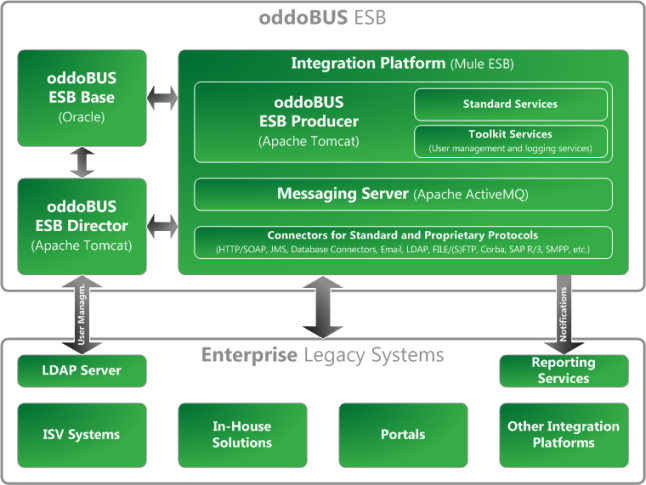
oddoBUS
Architectural view
oddoBUS ESB solution comprises the following components:
- oddoBUS ESB Monitor
- oddoBUS ESB Toolkit
- oddoBUS ESB Base
- Messaging server
- Integration platform
- Web server
- Database engine
Figure below shows oddoBUS ESB solution architecture. Example ISV or open source infrastructure is also shown for clarity reasons.

Figure 3 oddoBUS architectural view
User view
oddoBUS ESB solution differentiates the following user groups:
- End systems (legacy systems)
- Key business users
- Operations users
- Development users
End systems are calling and receiving legacy systems integrated via oddoBUS ESB solution. End systems are integrated via Messaging server and Integration platform, using standard technologies and protocols.
Key business users use oddoBUS ESB Monitor solution for tasks such as:
- Monitoring of business processes
- Manual interaction as part of some business processes (e.g. approval/rejection, confirmation that parts of the business process outside of oddoBUS ESB solution are done etc.)
Operations department users use oddoBUS ESB Monitor solution for tasks such as:
- Monitoring of business and technical processes
- Manual interaction as part of some business processes (e.g. approval/rejection, confirmation that parts of the business process outside of oddoBUS ESB solution are done etc.)
- Runtime Management
o Processes management
o Exception management
- Transport management
o Messaging management
o Routing management
- User management
o End systems access rights
o End users access rights
Furthermore, operations department performs administration tasks on Messaging server and Integration platform.
Development users use oddoBUS ESB Toolkit for development and customization of the oddoBUS ESB solution.
The following matrix shows user groups’ usage of various oddoBUS ESB components.

Figure 4 oddoBUS component/user matrix